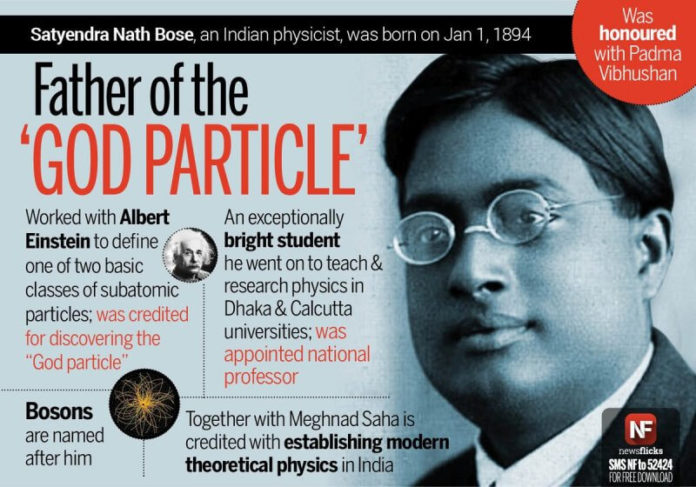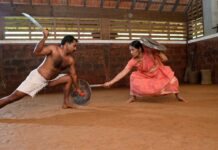By Aseema Team
Satyendra Nath Bose was an eminent physicist after whom ‘Bosons’, one of the two classes of particles in quantum mechanics, was named. He was a self-taught scholar who rose to prominence during the 1920s for his work on quantum mechanics and went on to work with the renowned German physicist, Albert Einstein.”
 |
Satyendra Nath Bose (January 1, 1894 – February 4, 1974) was a Bengali Indian physicist, specializing in mathematical physics. He is best known for his work on quantum mechanics in the early 1920s, providing the foundation for Bose-Einstein statistics and the theory of the Bose-Einstein condensate. He is honoured as the namesake of the boson. Although he was not awarded the Nobel Prize, more than one such prize was awarded for research related to the concepts of the boson, Bose-Einstein statistics and Bose-Einstein condensate—the latest being the 2001 Nobel Prize in Physics, which was given for advancing the theory of Bose-Einstein condensates. Among his other talents, Bose knew many languages and also could play the Esraj (a musical instrument similar to a violin) very well. In his book, The Scientific Edge, noted physicist Jayant Narlikar observed:”S.N. Bose’s work on particle statistics (c. 1922), which clarified the behaviour of photons (the particles of light in an enclosure) and opened the door to new ideas on statistics of Microsystems that obey the rules of quantum theory, was one of the top ten achievements of twentieth-century Indian science and could be considered in the Nobel Prize class. Achievements & Recognitions:
|
|
| Born | January 1, 1894, Calcutta, India | |
| Died | February 4, 1974 Calcutta, India |
|
| Residence |  India India |
|
| Nationality |  India India |
|
| Field | Physics | |
| Institutions | Calcutta University University of Dhaka |
|
| Alma mater | Presidency College | |
| Academic advisor | Jagdish Chandra Bose | |
| Known for | Bose-Einstein statistics | |
Early life and Career
Bose was born in Kolkata (Calcutta), West Bengal, India, the eldest of seven children and only son. Bose became known as S.N. Bose in the scientific community but was called Satyen Bose in his native Bengal. His father, Surendranath Bose, worked as an accountant in the Engineering Department of the East India Railway. Surendranath was inclined towards mathematics and was interested in several branches of science. He even founded a small chemical and pharmaceutical company. Apart from science and mathematics, S.N. Bose’s father was also involved with philosophical studies, including the Hindu scriptures like Bhagwad-Gita. In 1964, Surendranath Bose died at the age of ninety-six, after having witnessed Satyen Bose’s seventieth birthday. Bose started to attend Hindu School in Calcutta when he was only 13 years of age, and later attended Presidency College, also in Calcutta, earning the highest marks at each institution. At Presidency College Bose met other contemporary scholars, including Meghnad Saha, with whom he became a close friend. Bose finished studies here with the first rank in both B.S. (Bachelors in Science) and M.S. (Masters in Science). During his final year, he was wed (in an arranged marriage) to 11-year-old Ushabala Ghosh. They had two sons and five daughters (apart from two others who died in infancy). It was a time of great political unrest, and career outlook was not good. Ioan James of “Remarkable Physicists: From Galileo to Yukawa” stated, “…the Indianization of education was creating opportunities for able youngsters like Bose and Saha. The University of Calcutta, founded in 1857, was being transformed into a national institution, free of British influence. The Vice-Chancellor and moving spirit behind this development, Sir Asutosh Mookerji, was himself a mathematician. The two friends decided to devote themselves to study and research in physics. Unfortunately, modern physics, such as relativity and quantum theory, was not treated in the textbooks available to them, and they had no access to scientific journals. Moreover, laboratories did not exist. Planck, Einstein, and Bohr were just named to them. However, Sir Asutosh was impressed by the willingness and enthusiasm of the aspiring young scientists and agreed to help them prepare to teach postgraduate courses in physics and mathematics. He granted them scholarships and arranged facilities for procuring scientific journals and working in laboratories.”Eventual paths took Bose to study electromagnetism and relativity. He came in contact with brilliant teachers such as Jagadish Chandra Bose (no relation) and Prafulla Chandra Roy who provided inspiration to aim high in life. From 1916 to 1921 he and Saha became lecturers in the physics academic department of the University of Calcutta. Later, Bose and Saha began research in statistical mechanics, publishing their first paper in 1918. After getting Einstein’s permission, they published (in translation) an anthology of Einstein’s papers on relativity and quantum theory. Bose then secured a non-tenure position (similar to assistant professor) at Dacca University, where he led the postgraduate work of the department. In 1921, he joined the Department of Physics of the then recently founded Dacca University (now in Bangladesh and called University of Dhaka), again as a lecturer. In 1924 Bose wrote a paper deriving Planck’s quantum radiation law without any reference to classical physics. After initial setbacks to his efforts to publish, he sent the article directly to Albert Einstein in Germany. Einstein, recognizing the importance of the paper, translated it into German himself and submitted it on Bose’s behalf to the prestigious Zeitschrift für Physik. As a result of this recognition, Bose was able to leave India for the first time and spent two years in Europe, during which he worked with Louis de Broglie, Marie Curie, and Einstein. Bose returned to Dacca in 1926. He became a professor and was made the head of the Department of Physics, and continued teaching at Dhaka University until 1945. At that time he returned to Calcutta, as the successor to Venkata Raman as professor of physics. After teaching at Calcutta University until 1956, he retired and was made professor emeritus.
In the interim, the year 1954, as James states, “he was given a seat in the Rajya Sabha, the upper chamber of the national parliament, but did not play a very active role in Delhi. Two years later, after retiring from Calcutta University, he became Vice-Chancellor of the new central university of Visva-Bharati, which was closely associated with the ideas of the poet Rabindranath Tagore”
The error that wasn’t
|
There are three outcomes. What is the probability of producing two heads? The error was a simple mistake that would appear obviously wrong to anyone with a basic understanding of statistics, and similar to arguing that flipping two fair coins will produce two heads one-third of the time. However, it produced correct results, and Bose realized it might not be a mistake at all. He for the first time held that the Maxwell-Boltzmann distribution would not be true for microscopic particles where fluctuations due to Heisenberg’s uncertainty principle will be significant. Thus he stressed in the probability of finding particles in the phase space each having volumes h3 and discarding the distinct position and momentum of the particles. |
|
|||||||||||||||||||||||
|
Physics journals refused to publish Bose’s paper. It was their contention that he had presented to them a simple mistake, and Bose’s findings were ignored. Discouraged, he wrote to Albert Einstein, who immediately agreed with him. Physicists stopped laughing when Einstein sent Zeitschrift für Physik his own paper to accompany Bose’s, which were published in 1924. Bose had earlier translated Einstein’s theory of General Relativity from German to English. It is said that Bose had taken Albert Einstein as his Guru (mentor). Because photons are indistinguishable from each other, one cannot treat any two photons having equal energy as being different from each other. By analogy, if the coins in the above example behaved like photons and other bosons, the probability of producing two heads would indeed be one-third (tail-head = head-tail). Bose’s “error” is now called Bose-Einstein statistics. |
||||||||||||||||||||||||
Later work
Bose’s ideas were afterwards well received in the world of physics, and he was granted leave from the University of Dhaka to travel to Europe in 1924. He spent a year in France, where he worked with Marie Curie and met several other well-known scientists. He then spent another year abroad, working with Einstein in Berlin. Upon his return to Dhaka, he was made a professor in 1926. He did not have a doctorate, and so ordinarily he would not be qualified for the post, but Einstein recommended him. His work ranged from X-ray crystallography to grand unified theories. Together with Meghnad Saha, he published an equation of state for real gases. In addition to physics, he did some research in biochemistry and literature (Bengali, English). He studied other sciences—chemistry, geology, zoology, anthropology—and engineering in depth. Being of Bengali origin, he devoted a lot of time to promoting Bengali as a teaching language, transliterating scientific papers into it, and promoting the development of the region. Satyendra Nath Bose died on February 4, 1974, shortly after his eightieth birthday.












